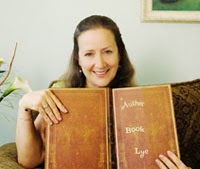by Pam Withers, www.pamwithers.com
Few people have put as much time and effort into figuring out
what makes a book club successful as Christianne Hayward, who
has been running them for sixteen years.
As a single mother of two boys (one a keener reader than the other), she decided to apply her Ph.D. in education toward inspiring a love of reading in children of all ages. She started her first parent-and-youth book club at the
local community center as a way to ensure that her sons had a
literary group to socialize with. This book club was so well received
that she added a new book club each year, culminating in seventeen
parent-and-youth book clubs ranging from preschool to grade
twelve.
Today, her Lyceum of Literature and Art in Vancouver,
Canada (http://www.christiannehayward.com/), provides a unique, cozy, and specialized learning environment that brings forth the best of afterschool reading and writing
experiences for hundreds of children per week. Her book clubs are
a family affair where parents read the books, attend the groups,
and participate in the discussion along with their children.
Hayward serves as a consultant to educators and book club
leaders around North America. What she finds most gratifying,
however, is running into families of her grown students who say,
“You made such a difference. Even though my child attended your
club for only a year, he became a reader for life.”
Q: What are some of the key ways you engage the boys in
your clubs, as opposed to the girls?
A: First, you need a lot of humor. Boys respond well to a bit of
lighthearted ribbing. Second, I serve food and hot chocolate, hot
apple cider, or herbal teas; humans gather more willingly if food
is involved. (At home, we all settle in with a comfort drink in a
comfortable space to read.) Third, I put up lots of books with
male protagonists and subjects to which boys can relate easily.
A democratic voting system for selecting the books to be read,
buys a certain ownership and involvement from all participants.
Fourth, I use kinesthetic ways of learning: crosswords that test
whether they’ve taken in details of the book we’ve just read, art
projects connected to the book’s scenes, and breaks that feature
food mentioned in the book. Finally, I let them move around. In a
photo of a kindergarten story-time at the Lyceum, you can see the
girls sitting straight and staring at the book, and the boys lounging
on the pillows. But if you look closely, you can also see how incredibly
engaged those boys are.
As for the older boys, I tell them that the best way to understand
that strange group of people called “girls” is to read some books
with a female protagonist. It’s amazing how they internalize that.
Once I ran into a boy in second-year university who’d been in one
of my book clubs years before. “You were so right about that!” he
enthused.
Q: Some of the boys in your clubs come with their mothers,
and some with their fathers. How important is the gender
role-model factor?
A: For the boys to see a male involved in a book club is huge, but it
doesn’t have to be their father. We often get uncles, older brothers,
and grandfathers and everyone benefits from their presence. Boys
who come with their mothers forge better communication with
them than boys who don’t; book clubs allow the mothers to talk
to their sons about difficult topics through a literary character.
Dads who attend our clubs raise the bar for everyone, because
they tend to be avid notetakers and they hate not doing well on
the crosswords.
Most importantly, the youth see men reading and discussing
reading, or what I call “socializing around reading.” Women do
this more naturally, while men tend to socialize around sports or
games instead. Since coaches don’t usually read books between
periods, and guys don’t typically discuss books after a game, you
have to find a way to expose them to this modeling, by making an
effort at home or enrolling them in a book club.
Q: Roughly what percentage of boys are reluctant
readers?
A: In my experience, it can be as high as forty percent. The divide
begins in about fourth grade, and has to do with under-acknowledged
brain differences, a lack of books that interest boys (especially
after sixth grade if they’re not into fantasy), not seeing men
socialize around reading, and a more auditory-driven education
system. Boys often respond better to kinesthetic and visual
learning: Pictionary, graphic books, charades, dramatizations,
debates, crosswords, exercise balls for sitting, and art. At-home
reading and book clubs can cater to these needs more easily than
traditional classrooms. The optimal point at which you can make
a big difference is in grades four, five, and six, by choosing books
that are fun and engaging, by pumping up the number of graphic
books you let him read, and by modeling and sharing your passion
for reading at home.
Q: Some parents steer their kids away from picture books
and graphic novels before the child wishes to give them up,
on the assumption that these are unsophisticated forms of
reading holding him back. What’s your advice?
A: Don’t get too stuck on this. Our youth have to be more visually
literate than we were, able to deconstruct symbols in images
and make meaning. Even PowerPoint presentations at CEO meetings
today have more animation, logos, and visual symbols. When
parents read a graphic novel, it seems choppy to them, but today’s
children know how to bridge between cells in much the same way
you do between lines of a poem. Graphic books engage a different
type of literacy. This doesn’t replace textual literacy but is just as
important.
If you keep throwing books at your boy that are too difficult,
you’ll lose him. One of my sons didn’t read for enjoyment until age
ten; it was a graphic novel that finally hooked him. He’d always
been able to decode competently, and had been read to, but reading
for enjoyment took longer to kick in. Get them graphic books,
auditory tapes, interactive books online, whatever it takes. Keep
them in the game until their maturity catches up with them.
Q: What’s your best advice to parents who want their child
to be a keen reader?
A: Let him be involved in choosing what he reads, and continue
reading to him even after he can read by himself. Where you apply
your greatest influence in what your son reads is through the
books you read to him. Start reading to him long before seventh
or eighth grade; otherwise he might be less open to reading aloud
experiences. Choose themes that interest him, books that have the
hook within the first chapter. Read several chapters ahead yourself
before sitting down with him, so you won’t stumble over names
and if you start to lose his attention, you can synthesize what’s
happening and take him forward to an exciting bit, closing on a
cliffhanger if at all possible. This way, he’ll plead and beg you to
read more, but don’t give in. Make him come to the book hungry
the next day. Also, read to your kids when you’re fresh. For me as
a single mother, being fresh meant early in the morning instead of
at bedtime, and always in the same space with our comfort drinks
in hand.
There are three kinds of reading: independent reading (he reads
by himself, preferably books he has chosen; no more than one error
per page), guided reading (he reads a page, you read a page; no
more than four errors per page), and reading aloud (you do all the
reading). There’s typically a two-year reading-level gap between
expressive and receptive language development, meaning there
is a dramatic spread between what he can read on his own and
what he can understand orally. By reading aloud, you’re building
the scaffolding that will make him a stronger reader, helping him
understand patterns, reinforcing his ability to predict plotlines,
helping him understand causal relationships, and exposing him to
the cadence of oral language.
Q: Why is it important to learn to enjoy reading?
A: Reading is an investment in yourself, an education in itself. It
nurtures curiosity and a thirst for learning more; it can be very
addictive once you have a good experience with it. Literacy is
incredibly important for accessing information, engaging personal
growth, and nurturing breadth of knowledge. It supports emotional
intelligence, which you need in order to excel at the top levels
of industry. Emotional intelligence helps you relate to someone
different than you at work. It helps you articulate your thoughts,
which can boost your ability to speak in front of a group. Broad
reading exposes you to other perspectives, which is very precious
in a diverse society.


